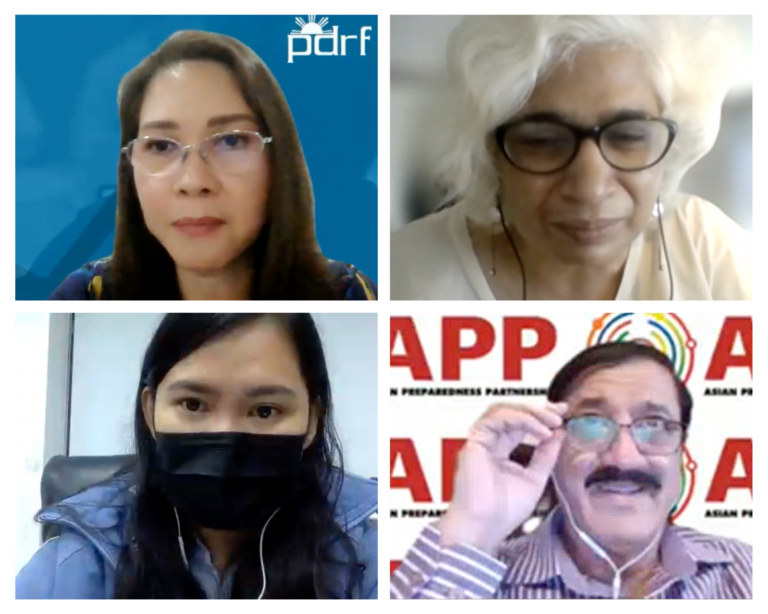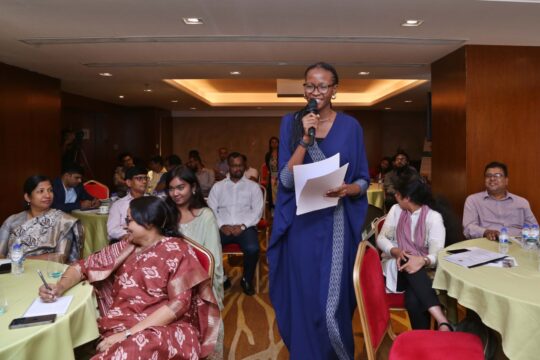The third meeting of the Regional Technical Working Group on the Nexus between Risk Analytics, Early Warning Systems, and Emergency Operations Centers (RTWG- RA, EWS, EOCs) took place on 8 September 2021. There were 34 participants at the meeting which included the nominees from the Asian Preparedness Partnership (APP) countries, the APP program team, and participants from Bangladesh and Laos PDR through the APP+ approach. The meeting provided an opportunity to share good practices on the nexus and existing relevant guidelines and standard operation procedures (SOPs). The eventual goal is to create a repository for these relevant documents to promote South-South learning and knowledge exchange. The session also sought to proposed capacity-building activities regarding RA, EWS, EOCs in the APP countries.
The meeting was chaired by Ms. Veronica Gabaldon, Executive Director of the Philippine Disaster Resilience Foundation (PDRF). She welcomed the participant to the meeting and requested Ms. Shalini Kanwar, APP Program Lead, to give opening remarks. She expressed her interest in the member country presentations as it would be an ideal opportunity to share the interventions, strategies, and policies. Mr. Sajid Naeem, Senior Country Program Manager of Asian Disaster Preparedness Center (ADPC) Pakistan, provided updates and greeted the new partners. He reflected on the previous meeting and future activities including the development of case studies and sharing country-specific information on the nexus.

The updates were followed by a series of presentations from the representatives of the APP countries. The first presentation on the institutionalization of pre-disaster risk assessment was given by Ms. Rachelle Miranda, Training Officer and Deputy Spokesperson of the Office of Civil Defense (OCD) Philippines. She detailed the assessment’s science-based approach and multistakeholder approach. The system collected data from numerous sources and includes the government, non-governmental organizations (NGOs), and the private sector. Ms. Gabaldon supported the presentation with PDRF’s triple whammy strategy. The foundation’s approach provides resources for government initiatives and works to build partnerships with other stakeholders.
The presentation continued with from the following countries:
- Mr. Prak Kim Hong, Deputy Secretary-General of the National Committee for Disaster Management (NCDM) Cambodia presented the development, roles and responsibilities, and capacity-building initiatives of the NCDM’s emergency operation center (EOC). He continued with an overview of the early warning system (EWS) that was developed by the Ministry of Water Resources and Meteorology (MoWRAM).
- Mr. Sushi Bhandari, Section Officer of the Ministry of Home Affairs Nepal, presented on the capacity building activities in Nepal. These interventions included establishing an extension of Humanitarian Staging Areas for emergency operations, integrated common disaster management information systems, extension and networking with automation of hydro-meteorological and river gauze stations, and training community volunteers on EWS. He concluded with updates on SOPs regarding flood ESW, common alert protocols, and multi-hazard assessments.
- Mr. Muhammad Tahir Uddin, Deputy Director of the National Disaster Management Authority (NDMA) Pakistan, presented on the collaboration with the National Institute of Disaster Management (NIDM). They have jointly trained 8,762 persons on the Comprehensive Human Resource Development Plan in the last 10 years. The authorities are moving towards digitizing the lessons and establishing a disaster information resource center.
- Ms. Aimee Mengulla, Civil Defense Officer of the OCD Philippines, presented the numerous guidelines and SOPs developed in the Philippines. She elaborated on the digital approach which includes free mobile alerts in times of emergencies and the National Disaster Risk Reduction and Management Council’s (NDRRMC) monitoring dashboard app.
- Brigadier Kanishka Heiyanthuduwa, Director (Emergency Operations) of the Disaster Management Centre (DMC) Sri Lanka, presented on the National Emergency Operations Plan and SOPs in place for cyclones, floods, landslides, and tsunamis. He also explained the disaster risk reduction (DRR) capacity-building programs for government officials, NGOs, and other stakeholders.
Ms. Veronica Gabaldon gave summarized the main points of the presentation and emphasized the importance of such regional platforms. Ms. Shalini Kanwar concluded the meeting by thanking all of the presenters for their insights and encouraged them to continue to share their experiences as an opportunity for regional learning.


